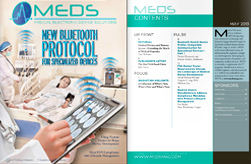For many years, Intel has been known as the silicon giant providing solutions to the PC platform including desktops, notebooks, netbooks, tablets, and now handheld and wirelessdevices. We all have heard about the digital health talk for many years, but we are starting to see real products being introduced to support remote healthcare using digital technology. These applications include remote diagnosis of heart rhythm using digitized waveform, even on an iPhone or Android device.
Medical Electronic Device Solutions magazine catches up with Intel to find out what the chip giant is doing in the digital health segment. The interviewer is our Publisher John Koon.
Publisher: Edward, what is Intel’s vision on Digital Health?
Edward: At the server level, Intel is involved with the IT operation supporting electronic health records (EHR) and electronic medical records (EMR). On the embedded side, Intel focuses on providing solutions in making digital health work. This in turn will enable developers to provide better hardware products and reduce cost overall.
Publisher: What are the opportunities and challenges developers face today?
Edward: While there are a lot of discussions of medical electronics on the diagnostic side to monitor the patient’s health condition, equally important are the opportunities on the preventative side such as fitness and exercise machines. Additionally, there are a lot of demands on bedside entertainment devices. We are at an early stage of the medical electronics revolution. As more and more devices become connected to each other and to the Internet, there are a lot of challenges and opportunities for developers. Some of the challenges include interoperability, security concerns and how to create better user experiences.
Publisher: What is Intel doing to help developers to overcome these challenges and capture new opportunities?
Edward: Intel believes the best user experience is offered on Intel architecture. In order for developers to be able to use Intel processors there are a few challenges that must be overcome. I will go through these one by one.
- Interoperability. When a device operates in a stand-alone environment there is no concern of interoperability. As more and more devices are connected in hospitals or labs, this issue will become more pronounced. The key is how do these devices plug and play together to provide the results the users need without having to hire a whole IT team.
- Security. Remote healthcare is being talked about a lot these days. Once a device is connected to the wireless network, security becomes a major concern. How can we make sure that a device is sending the data to the intended users? Don’t forget we are dealing with personal and private medical data. Another concern is quality of service (QoS). In an application of multi-tasking, how can we be sure that the connected device can service the patient in a timely fashion and is not spending cycle time to handle the network handshaking? For example, when a connected oxygen-monitoring device encounters a problem, we want to make sure that the machine will sound an alarm to the healthcare team and not worry about a networking issue. Multicore will address these concerns.
- Better user experience. As medical electronics are becoming more advanced, users come to expect a better experience. How can technology help? Here is a scenario. A patient recovering in the hospital usually relies on watching TV for entertainment. If it is a double-occupancy room, they have to share the TV. We think the bedside-terminal system with on-demand movie/music and other server-based entertainment will be a good first step toward having better user experiences.
Publisher: Interoperability is a major challenge today. What is being done to solve that problem?
Edward: Intel is very involved with the group called MD PnP. This organization focuses on helping medical devices to achieve “plug-and-play” Interoperability. Additionally, the MD PnP program is leading the adoption of open standards and technology to integrate medical devices for improving patient safety and healthcare efficiency. This in turn will reduce the cost of operation.
Publisher: What is Intel’s strategy in the fitness market segment?
Edward: The best medicine is preventative. Fitness marketing is growing and Intel’s goal is to focus on providing solutions in smart exercise machines, which are adaptable to the users. There will be touch screen functionality. It can provide motivational images and video streaming of a winning biker or an Olympic gold medalist. Additionally, these exercise machines such as treadmills can be equipped with intelligence to personalize different exercise goals for individuals who are recovering from, say, an injury. The possibilities of fitness and exercise are limitless.
Publisher: Ed, it was very nice to chat with you and learn about Intel’s vision in the medical electronic segment. Please keep us informed of any new innovations in the upcoming months.
Edward: We will be glad to do that.

